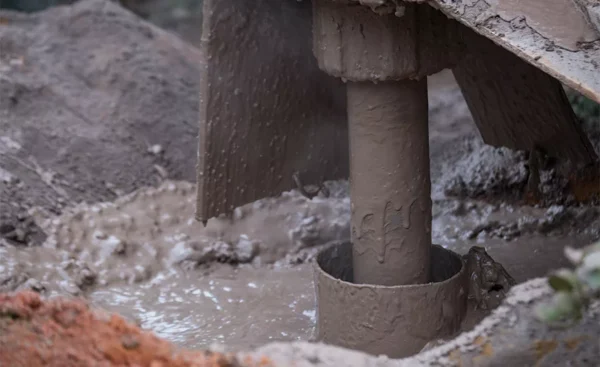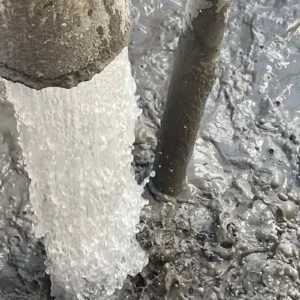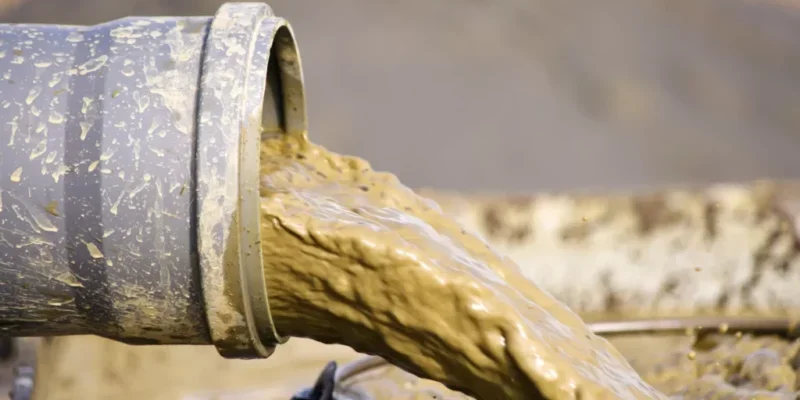In large projects, like creating wells for oil and gas extraction, drilling mud is pumped into boreholes to cool down the drill bit, grease the drill, carry rock cuttings to the surface, support the wellbore, and control the pressure. Drilling mud can contaminate the soil and water if left untreated, especially when they are mixed with toxins and chemicals. Therefore, they should be cleaned of harmful substances before returning to the environment. In the following text, we discuss different techniques of drilling mud disposal, explain how drilling mud puts the environment at risk, and more.
What is Drilling Mud?
Drilling mud is a thick liquid used in drilling operations. Its base ingredient is water (most common), oil, or gas; however, the engineers must add bentonite clay and barite to balance its density and viscosity. There are different types of drilling muds depending on the materials used and the purpose of the drilling. Unfortunately, when drilling ends, this mud becomes waste, and disposing of it is a big challenge.
3 Types of Drilling Muds (Based on Their Base Ingredient)
1. Oil-Based
The main ingredient in oil-based muds is mineral or synthetic oils. Oil is usually used in drilling very deep wells, as it lubricates the drill bits better. But these muds are usually toxic, flammable, and non-biodegradable.
The best disposal methods:
- Thermal treatment or incineration to destroy hydrocarbons.
- Removing solids and recovering the base oil for further use.
2. Water-Based
In water-based muds, fresh water, seawater, or brine is the main component. The engineers usually add bentonite clay and barite to increase its density, and other chemicals to control its viscosity. Although water-based muds are less harmful than oil-based ones, they still contain chemicals and heavy metals.
The best disposal methods:
- Landfarming and bioremediation to break down pollutants.
- Dewatering and pit burial.
3. Air-Based
Air-based drilling mud, also known as aerated or pneumatic drilling fluid, uses compressed gas instead of water or oil. Pneumatic drilling fluid is cheaper and super eco-friendly, but it is only suitable for extremely hard and dry rocks.
The best disposal methods:
- Pit burial.
- Reuse in construction or land reclamation if the toxins are removed.

The Best 5 Techniques for Drilling Mud Disposal
Drilling mud removal must be done carefully to avoid soil, air, and water contamination. The best disposal techniques in 2025 include:
1. Landfarming
This is the most cost-effective and energy-efficient method of drilling mud disposal. It is a simple procedure, but it only works for non-hazardous, water-based muds. Landfarming involves two main steps:
a) The waste mud is spread on a large, well-prepared land. Then, the machines mix it with topsoil.
b) The microbes break down the organic materials into less harmful materials, such as carbon dioxide, water, and biomass.
2. Pit Burial or Landfill
In this method, the mud is first dried through natural evaporation, chemical solidification, or aeration. When the waste is completely dewatered, it is buried in the same pit or in an adjacent well. Finally, the burial pit is covered with soil to return the land to its natural state. The cover also prevents animals from scavenging and blocks disease spread.
3. Thermal Desorption
This is an expensive method of removing drilling mud, yet it is the best one to get rid of oils and chemicals. After separating large stones, the remaining mud is heated in a kiln to 500°C. This procedure recovers hydrocarbons from the mud. The vaporised hydrocarbon is then reused in later drilling operations.
4. Recycling and Reuse
Some muds, especially oil-based ones, can be cleaned and reused after removing large particles and contaminants. Shakers, hydrocyclones, and centrifuges are usually used to refine and return the fluid to the drilling operations.
5. Solidification/Stabilisation (S/S)
In this technique, binding agents like cement, fly ash, or lime are used to turn liquid mud into a solid waste. The dry material can then be used in construction or be buried in the pit burials.

How Does Untreated Drilling Mud Impact the Environment?
Improper drilling mud disposal can damage the ecosystem and wildlife. Oil-based muds affect the plant’s growth, harm aquatic life, and reduce soil fertility. Some wastes also contain toxic metals like barium, chromium, or lead, which can remain in the soil for decades. In addition to the environment, untreated drilling mud might put workers’ lives at risk. Skin irritation, respiratory issues, headaches, and nausea are the most reported health issues by the exposed workers.
What Type of Drilling Mud Is Hazardous?
Drilling mud is classified as hazardous if it:
- Contains high levels of toxic substances (like oil, heavy metals, or sulphides).
- Is flammable, corrosive, or reactive.
- Fails environmental safety tests, such as the Toxicity Characteristic Leaching Procedure (TCLP).
In general, oil-based mud (both synthetic and mineral) is the most hazardous type of waste mud because it is extremely flammable and contains high levels of toxins, such as benzene and xylene. On the other hand, water-based mud is the least hazardous one, unless it is mixed with contaminants from the wellbore, especially hydrogen sulphide.
The Last Words
Drilling mud keeps drilling operations safe and effective, but what happens to its waste is also important. The way we handle drilling mud removal can make a huge difference for our environment. If oil and chemicals leak into the soil or water sources, the nearby flora and fauna will be damaged. So, we must make sure today’s work doesn’t cause tomorrow’s problems. By using smarter methods like recycling and treatment, we can reduce mud waste and keep our surroundings clean. AquipTech (AIMEQUIP) is one of the top Australian companies focusing on wastewater treatment. With its advanced engineering solutions and industrial machinery, it helps protect the planet we live on.
Also Read: Advanced Water Treatment Technologies: Enhancing Efficiency and Sustainability
FAQs about Drilling Mud Disposal
1. Why is drilling mud disposal important?
Wrong drilling mud disposal can pollute soil, water, and air, and increase the health and environmental hazards. It can also negatively affect the flora and fauna of the area.
2. Can drilling mud be recycled?
Yes. Many components can be recovered and reused. Of course, recycling is mostly used for oil-based and air-based muds.
3. Which type of drilling mud is most harmful to the environment?
Oil-based muds are the most harmful because they contain hydrocarbons that are toxic, extremely flammable, and non-biodegradable.
4. What happens if drilling mud leaks into the ground?
It can contaminate groundwater and lower soil fertility. To prevent such problems, the engineers place a membrane at the bottom of the burial pits. In some cases, they also divide the buried waste into two parts and place a geo-membrane between them. In this way, they can detect any leakage that might occur.

